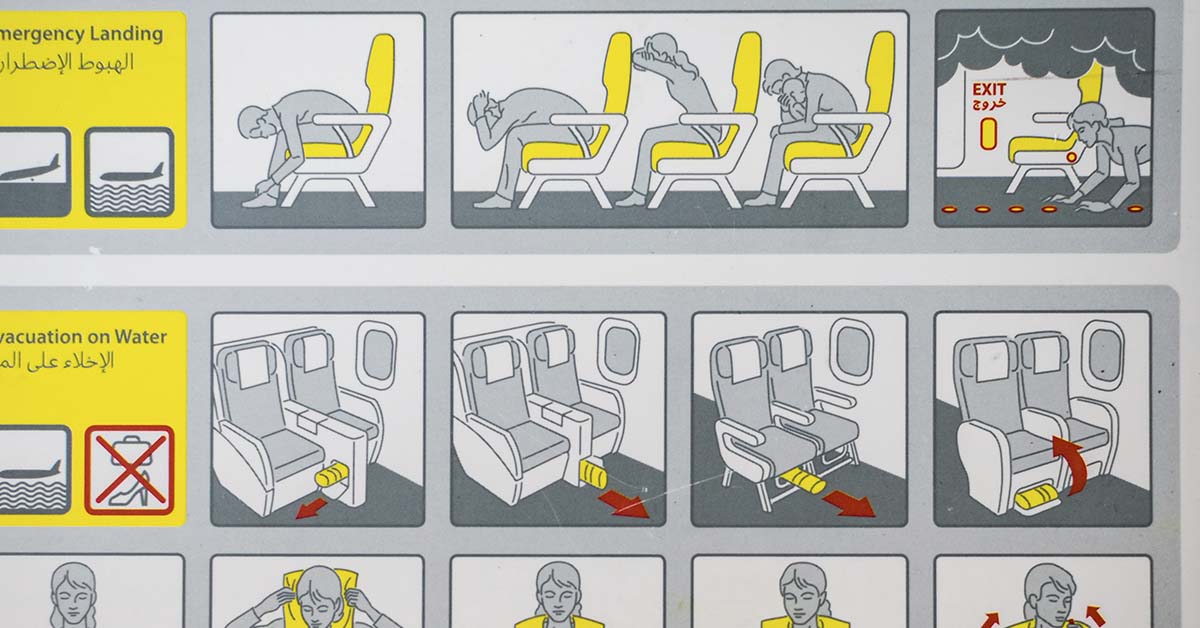If you’ve flown anywhere, you know the deal. You board, the flight crew describes the safety procedures to you, you fasten your seatbelt and off you go. Have you ever wondered though why they tell you to do certain things when emergencies strike? For example, what does the bracing position actually do to help?
From turning your phone on airplane mode to pulling up the window blinds before landing, rules have meaning
The brace position refers to the position you take during an imminent emergency landing. It involves leaning forward so that you’re laying on your upper legs and bringing your hands over your head. The position aims to protect you from the worst injuries when landing abruptly.
There are long-running rumors that suggest that the brace position is designed to kill passengers on impact – this is simply untrue
A top pilot has stepped forward to clear up these rumors stating that they are simply untrue. The morbid theory holds no value, and the brace position is designed to protect people. Nick Eades, the world’s most experienced Boeing 747 pilot, was more than happy to share his extensive knowledge with LADBible.
“What you’re trying to do is to stop people breaking their necks in a big impact.” He continued: “You’re just trying to get the body into a position that’s going to suffer the least damage. It’s like whiplash – you’re trying to avoid that sudden movement of the head, which can result in serious injury, if not death.”
Read: 7 Things Flight Attendants Notice About You When You Board an Airplane

The Self Improver: A Pilot’s Journey
The Self Improver: A Pilot’s Journey, a book written by Eades details his success as a pilot. The book also explains how times have changed in the aviation scene. The cabin crew, for example, will no longer tell people to brace, as their entire safety method is changing and evolving. Having been in the industry for over 40 years, Eades knows better than anyone. He thought back to some encounters he has personally been through, from technical difficulties to weather problems. Multiple times, he has told passengers to adopt the brace position in flight.
Eades said: “I’ve had a couple where we had problems with the landing gear, and the cabin crew shouts to all the passengers, ‘Brace, brace!’ Now, if you think about it, I would say at least half – probably three-quarters – of passengers on the airplane don’t speak English as a first language. And if you think about it, what does ‘brace’ mean? It took a long time for the aviation world to realize if you’re suddenly thrown into an emergency situation and people start shouting ‘brace’ at you, you might think, ‘What the hell do they mean?'”
Read: Flying is scary for most but this pilot had a life-changing experience at 23,000 feet in the sky.
While the position will remain the same, the way the instructions are delivered will change
Eades said: “The brace position is going to become redundant, so cabin crew won’t shout ‘brace’ at you anymore. They’ll say, ‘Head down, hands over your head. Head down, hands over your head.’ At least that gives somebody in probably the most stressful position they’ll ever be in their lives something to do.“
The positioning of seats are also being affected as not all face forward anymore. This means that a different position may be needed. He even goes into detail regarding why the lighting is dimmed and the shutters should be open when the plane is landing. It all started with an incident that dates back to the 1970s.
He said: “In Rhodesia in the 70s, they had a war and there was a viscount – which is a four-engine propeller airplane – coming in to land. But all the blinds were up and that gave the terrorists – the guerillas in the jungle – something to shoot at. What these guys were doing was they were waiting for the airplane to come in and the lights were all on. They could actually see something and they shot two of the viscounts down, with a loss of life.”
Aside from preventing the airplane from becoming a target, there is another safety aspect as well
Eades continued: “Let’s say you’re landing at night. If the blinds were all down and the lights were up, if suddenly everything became dark, it takes the human eye quite a long time to react to the change in light. So what we do now is we dim the airplane for landing at night, and we lift the blinds up so people can see out, and also so their eyes are adjusted to the light.”
He added: “A part of the eye opens and closes, and it takes a while to do that and to adjust to the light, so it’s just adjusting people to the environment, just in case there is a problem. You’ll have a far greater chance of being able to see what’s going on and getting out.” If you haven’t read his book yet, you totally should.
Keep Reading: Passenger With No Flying Experience Safely Lands Plane After Pilot Becomes Too Ill To Fly
Sources
- “Boeing 747 pilot explains real reason for ‘brace’ position on planes.” Leicestershire Live. Tom Vigar. February 9, 2023
- “World’s Most Experienced Pilot Reveals Truth About Why We Use Brace Position On Planes.” Lad Bible. Jess Hardiman. June 27, 2021

